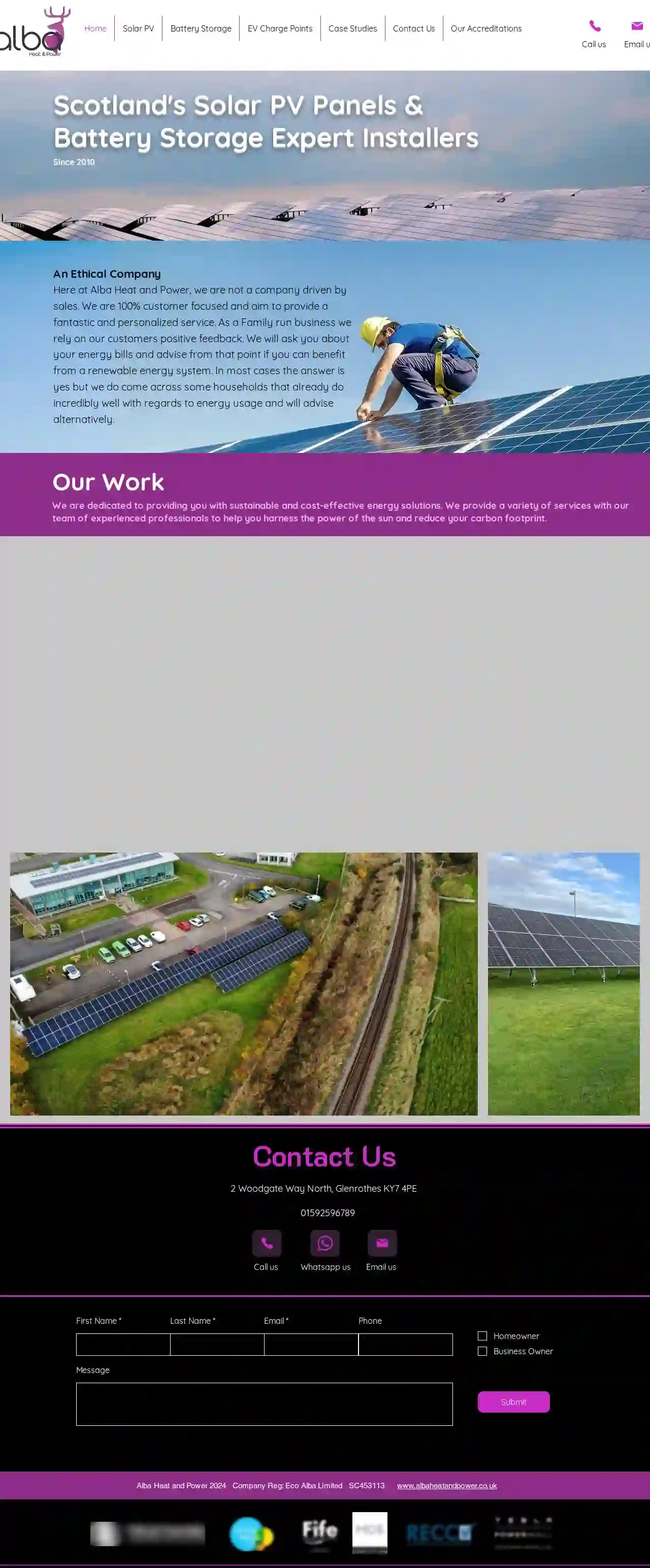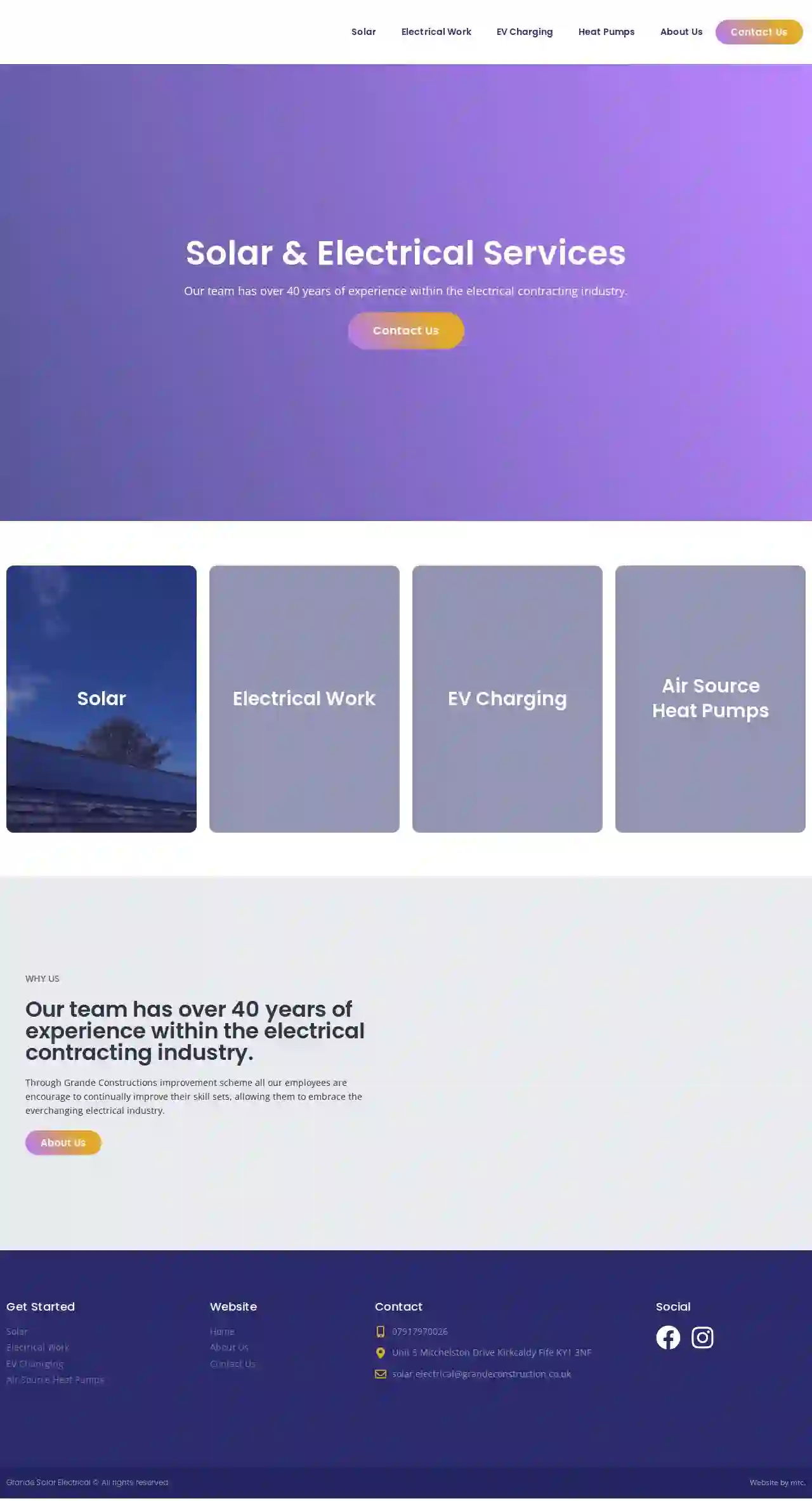Solar Installers Burntisland
Top Solar Installation Company in Burntisland
Get 3 FREE Solar Installation Companies quotes for your project today! Compare profiles, reviews, accreditations, portfolio, etc... and choose the best offer.

Power House Scotland Ltd
41 reviewsGlenrothes, Office 6, Itek House, KY7 4NS, GBPower House Scotland is a company dedicated to helping homeowners expand the potential of their homes through sustainable energy solutions. They offer a comprehensive range of products, including electric radiators, Sunamp water heaters, solar panels, battery systems, and car chargers, designed to empower homeowners to produce, buy, and store electricity. Their mission is to guide homeowners through every step of their energy journey, providing a greener and more sustainable future. Power House Scotland prides itself on its fully inclusive quotes, transparent pricing, and a team of reliable and knowledgeable experts.
- Services
- Why Us?
- Accreditations
- Testimonials
- Gallery
Get Quote
Alba Heat and Power
4.962 reviews2 Woodgate Way North, Glenrothes, KY7 4PE, GBHere at Alba Heat and Power, we are not a company driven by sales. We are 100% customer focused and aim to provide a fantastic and personalized service. As a Family run business we rely on our customers positive feedback. We will ask you about your energy bills and advise from that point if you can benefit from a renewable energy system. In most cases the answer is yes but we do come across some households that already do incredibly well with regards to energy usage and will advise alternatively. Our Work We are dedicated to providing you with sustainable and cost-effective energy solutions. We provide a variety of services with our team of experienced professionals to help you harness the power of the sun and reduce your carbon footprint.
- Services
- Why Us?
- Gallery
Get Quote
Grande Solar and Electrical
Unit 5 Mitchelston Drive, Kirkcaldy, KY1 3NF, GBGrande Solar Electrical is a company with over 40 years of experience within the electrical contracting industry. Our team is committed to continually improving their skill sets, allowing them to adapt to the ever-changing electrical industry. We offer a range of services including solar, electrical work, EV charging, and air source heat pumps.
- Services
- Why Us?
- Gallery
Get Quote
Mms Building Services Ltd
3.211 reviews5 Maryfield Crescent, Leslie, KY6 3JT, GBMMS Building Services is a family run business based in Fife that manufacture and construct eco friendly residential homes and commercial office buildings across the region and surrounding areas. Our highly experienced staff has the know-how to guarantee that our clients are completely satisfied with our custom built homes. We build small customized eco friendly homes using renewable energy, specializing in manufacturing small lodge size buildings that can be constructed at our premises. These are then transported to your location where we shall erect and fit out your building. Constructing green buildings is booming and the construction materials used are getting better every year. Our modern eco smart homes that we manufacture are designed and built to your requirements and we believe are affordable and in reach for everyone. Buildings can come with Solar Panels and underfloor heating and heat batteries. We are dedicated to finding the right home renewable energy solutions for the manufactured portable building that becomes your office or residential home. We are focused upon working with a select number of customers to help them build an energy efficient park home or bespoke lodge building.
- Services
- Why Us?
- Gallery
Get Quote
JH Electrical Contractor
4.98 reviewsFalkland, Falkland, Fife, Scotland, GBJH Electrical Contractor is a reliable and skilled electrical contractor and solar PV installer based in Falkland, Fife, Scotland. With years of experience and a passion for delivering top-notch electrical solutions, we are your go-to choice for all things electrical. Our team of experienced electricians is dedicated to providing efficient and innovative solutions tailored to your specific requirements. We pride ourselves on our expertise in a wide range of electrical services, including wiring and installations, lighting design, consumer unit upgrades, and energy-efficient solutions. We also offer 24/7 emergency service and solar PV and battery storage solutions for both homes and businesses. Our services include rewiring, letting agency, and ASHP installation. We are a certified company with a strong commitment to service excellence, flexibility, and affordability.
- Services
- Why Us?
- Gallery
Get Quote
Kirkcaldy Solar Panel Installers Fife
64 Cumberland Street, Edinburgh, EH3 6RE, GBHome Renewables Scotland is a leading provider of solar panels, solar installation, and renewable energy solutions in Scotland. With offices in Edinburgh, Aberdeen, and Glasgow, we offer a range of services including solar panel installation, solar battery storage, and air source heat pumps. Our team of experts is dedicated to helping homeowners and businesses reduce their carbon footprint and save money on their energy bills. Contact us today to arrange a free consultation and design plan.
- Services
- Why Us?
- Accreditations
- Gallery
Get Quote
Gener8 Scotland
4.58 reviewsPennyacre Court, Springfield, Cupar, KY15 5UL, GBGener8 Scotland is a family-run business dedicated to making solar panel installation affordable and accessible for everyone. Based in Springfield, Fife, they proudly serve all of Scotland and the islands, and are happy to travel throughout the UK. With over 20 years of combined experience in the industry, Gener8 Scotland is committed to providing high-quality solar PV panel and battery installations, as well as a wide range of other renewable energy solutions. Their focus is on customer satisfaction, ensuring that every client is happy with their service. They offer competitive prices and a 25-year warranty backed by the manufacturer.
- Services
- Why Us?
- Gallery
Get Quote
nextGenergy
51 reviews123 High Street, Brighton, BN1 1AA, GBNext Generation Energy (NGE) is a leading provider of innovative energy solutions, dedicated to helping businesses and individuals transition to a more sustainable future. With a team of experienced engineers and technicians, we offer a comprehensive range of services, including solar panel installation, battery storage, and energy efficiency audits. Our mission is to empower our clients with clean, reliable, and affordable energy, while minimizing their environmental impact. We are committed to delivering exceptional customer service and exceeding expectations in every project we undertake. At NGE, we believe that renewable energy is the key to a brighter future. We are passionate about developing and implementing cutting-edge technologies that reduce reliance on fossil fuels and promote a cleaner, healthier planet. Our commitment to innovation and sustainability drives us to constantly explore new ways to meet the evolving energy needs of our clients. We are proud to be a trusted partner for businesses and homeowners alike, helping them achieve their energy goals and make a positive difference in the world. With our expertise, dedication, and unwavering commitment to excellence, we are confident in our ability to deliver sustainable energy solutions that power a better tomorrow.
- Services
- Why Us?
- Accreditations
- Our Team
- Testimonials
- Gallery
Get Quote- Mc
McDonald Water Storage
4.510 reviewsKirkcaldy, GB- Services
- Why Us?
Get Quote - Ci
City Electrical Factors Ltd (CEF)
4.97 reviewsKirkcaldy, GB- Services
- Why Us?
Get Quote
Over 3,485+ Solar Installers in our network
Our solar installers operate in Burntisland and surrounding areas!
SolarCompaniesHub has curated and vetted the Best Solar Installers near Burntisland. Find the most trustworthy business today.
Frequently Asked Questions About Solar Installers
- Use a Directory Like SolarCompaniesHub: We connect you with pre-screened, qualified solar installers in your area.
- Check Online Reviews: Look for positive reviews on Google, Yelp, and other reputable sources.
- Ask for Referrals: Get recommendations from friends, family, or neighbors who have gone solar.
- Verify Credentials: Ensure the installer is licensed, insured, and certified by reputable organizations (e.g., NABCEP in the US).
- Get Multiple Quotes: Compare quotes from at least 3-4 installers to find the best value for your project.
- Ask Questions: Don't hesitate to ask installers about their experience, warranties, and the process they follow.
- Cash Purchase: The most straightforward option, providing the greatest long-term savings but requiring a larger upfront investment.
- Solar Loans: Loans specifically designed for solar installations, often with favorable terms and interest rates.
- Solar Leases: A third-party company owns the system and leases it to you, allowing you to go solar with little or no upfront cost, but you won't own the system or receive tax benefits.
- Power Purchase Agreements (PPAs): Similar to leases, but you pay for the electricity generated by the system, not the system itself.
- Home Equity Loans or Lines of Credit: Borrow against the equity in your home.
- Solar Panel Warranty: From the panel manufacturer, typically covering defects in materials and workmanship for 10-25 years. Some manufacturers offer performance guarantees, ensuring a certain level of energy output over time.
- Solar Installation Warranty: From the solar installer, covering the quality of the installation work for 1-10 years. This warranty protects you from leaks, faulty wiring, or other issues caused by improper installation.
- System size (measured in kilowatts, or kW)
- Type of solar panels (monocrystalline, polycrystalline, thin-film)
- Roof complexity (pitch, size, obstructions)
- Labor costs in your area
- Available incentives and rebates
How do I find a good solar installer near me?
How can I finance my solar panel installation?
What kind of warranty should I expect for my solar panel system?
What is the average cost of solar panel installation in UK?
How do I find a good solar installer near me?
- Use a Directory Like SolarCompaniesHub: We connect you with pre-screened, qualified solar installers in your area.
- Check Online Reviews: Look for positive reviews on Google, Yelp, and other reputable sources.
- Ask for Referrals: Get recommendations from friends, family, or neighbors who have gone solar.
- Verify Credentials: Ensure the installer is licensed, insured, and certified by reputable organizations (e.g., NABCEP in the US).
- Get Multiple Quotes: Compare quotes from at least 3-4 installers to find the best value for your project.
- Ask Questions: Don't hesitate to ask installers about their experience, warranties, and the process they follow.
How can I finance my solar panel installation?
- Cash Purchase: The most straightforward option, providing the greatest long-term savings but requiring a larger upfront investment.
- Solar Loans: Loans specifically designed for solar installations, often with favorable terms and interest rates.
- Solar Leases: A third-party company owns the system and leases it to you, allowing you to go solar with little or no upfront cost, but you won't own the system or receive tax benefits.
- Power Purchase Agreements (PPAs): Similar to leases, but you pay for the electricity generated by the system, not the system itself.
- Home Equity Loans or Lines of Credit: Borrow against the equity in your home.
What kind of warranty should I expect for my solar panel system?
- Solar Panel Warranty: From the panel manufacturer, typically covering defects in materials and workmanship for 10-25 years. Some manufacturers offer performance guarantees, ensuring a certain level of energy output over time.
- Solar Installation Warranty: From the solar installer, covering the quality of the installation work for 1-10 years. This warranty protects you from leaks, faulty wiring, or other issues caused by improper installation.
What is the average cost of solar panel installation in UK?
- System size (measured in kilowatts, or kW)
- Type of solar panels (monocrystalline, polycrystalline, thin-film)
- Roof complexity (pitch, size, obstructions)
- Labor costs in your area
- Available incentives and rebates